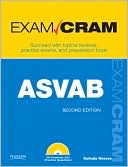ASVAB Exam Cram (Exam Cram Series)
Search in google:
ASVAB Exam Cram, Second EditionKalinda ReevesSucceed with topical reviews, practice exams, and preparation toolsCD Features 200 Practice Questions!ASVAB Exam Cram, Second Edition, is the perfect study guide to help you pass the ASVAB exam. It provides coverage and practice questions for every exam topic. The book contains an extensive set of practice questions, including 200 printed questions in two full practice exams, while the CD-ROM test engine provides real-time practice and feedback. The book covers the critical information you’ll need to know to score higher on your ASVAB exam! Master all four domains of knowledge covered on the ASVAB: verbal, math, science/technical, and spatial Accurately interpret the meaning of paragraphs and of words presented in context Review essential math, physical science, and biology principles Master the basics of electricity and electronics Understand the technologies that make automobiles and other vehicles work Check your knowledge of shop tools, terminology, and techniques Review and understand basic mechanical and physical principles Practice for the newest Assembling Objects exam module by recognizing how objects will look when they are put togetherCD Features 200 Practice Questions! Detailed explanations of correct and incorrect answers Multiple test modes Random questions and order of answers Coverage of every ASVAB exam objective
IntroductionChapter 1: General ScienceScientific Method: Observation and MeasurementUnits of MeasurementThe Physical SciencesChemistryPhysicsLife SciencesBiologyHuman Anatomy and PhysiologyEcologyEarth and Space SciencesGeologyMeteorologyAstronomyExam Prep QuestionsExam Prep AnswersChapter 2: Arithmetic ReasoningArithmetic: A ReviewBasic Arithmetic OperationsFractionsDecimalsUsing Fractions and Decimals on the ASVABReasoning: Using Arithmetic to Solve Your ProblemsWord ProblemsSeriesExam Prep QuestionsExam Prep AnswersChapter 3: Word KnowledgeUnderstanding ContextExperience CluesDefinition or Paraphrase CluesExample CluesComparison and Contrast CluesSynonyms and HomonymsWords and Their SynonymsUsing a ThesaurusWord Confusion: HomonymsFinding Word Meaning Through StructureRoot WordsPrefixesSuffixesBuilding Your VocabularyExam Prep QuestionsExam Prep AnswersChapter 4: Paragraph ComprehensionReading for DetailsReading for ComprehensionTopicMain CharacterSetting and TimePoint of ViewPlotObjectiveDenotation, Connotation, and ToneReading for Content, Context, and ComprehensionReading for Literal ContentReading for Figurative ContextGrouping SequencesDeveloping a SummaryImproving Your Reading AbilitiesImproving Your ComprehensionImproving Your Reading SpeedAdjusting Your Reading RateTips for Success on the Reading Comprehension ModuleExam Prep QuestionsExam Prep AnswersChapter 5: Mathematics KnowledgeTaking the Mathematics Knowledge TestAdvanced OperationsFactorsMultiplesThe FactorialsExponentsRootsWorking with Signed NumbersOrder of OperationsAlgebraAlgebraic PropertiesSolving Algebraic EquationsFactoring Algebraic ExpressionsInequalitiesGeometryLinesAnglesTrianglesQuadrilateralsCirclesVolumeExam Prep QuestionsExam Prep AnswersChapter 6: Electronics InformationSchematicsPrinciples of ElectricityCurrentElectromotive Force and VoltageResistance and ImpedanceConductors and ConductivitySemiconductorsInsulatorsOhm’s LawPowerElectrical Components and PropertiesBatteriesPhotovoltaic CellsElectrical WiringCoaxial CableResistorsTransistorsCapacitors and Capacitive ReactanceSwitchesMagnets and ElectromagnetsInductors and Inductive ReactanceTransformersAmplifiersRectifiers, Diodes, and InvertersThermocouplesElectrical SafetyDischarging a CapacitorElectrical FiresExam Prep QuestionsExam Prep AnswersChapter 7: Mechanical ComprehensionWhat Is Mechanics?Forces of MotionMotion and Mechanical LawsMechanical PrinciplesWork and Mechanical EnergyMechanical AdvantageFrictionCalculating EfficiencyPrinciple of Moments and TorqueSimple and Compound Machines.LeversWheel and AxlePulleysInclined PlanesWedgesScrewsGears and Other Simple MachinesStructural SupportStructure TypesBridgesLoad TypesMechanical and Structural PropertiesStressStrainModulus of ElasticityProperties of MaterialsMetalsCeramicsOrganicsSynthetics and PolymersFluid DynamicsSpecific GravityPressureArchimedes and Fluid DisplacementBernoulli and Fluid MovementExam Prep QuestionsExam Prep AnswersChapter 8: Shop InformationTools of the TradeShop SafetyMeasuring Systems and ToolsCutting and Shaping ToolsDrilling ToolsFastening Tools and FastenersShop ProcessesWeldingSolderingBrazingMachiningShop Project PlanningExam Prep QuestionsExam Prep AnswersChapter 9: Automotive InformationA Look Under the HoodA Word on SafetyTools of the TradeHand ToolsPower ToolsCleaning EquipmentEngine ClassificationsCombustion Types and Chamber ShapesCylinder ArrangementsValve ArrangementEngine CyclesEngine TypesRotary EnginePiston EnginesEngine SystemsLubrication SystemCooling SystemFuel SystemThe Drive TrainTransmissionsDrive Line ArrangementsDrive Train ComponentsElectrical SystemsCharging SystemStarting SystemIgnition SystemLighting and Accessory SystemThe Chassis SystemsThe Steering SystemThe Suspension SystemThe Braking SystemTires and WheelsExhaust Systems and EmissionsExhaust EmissionsReducing Exhaust EmissionsExam Prep QuestionsExam Prep AnswersChapter 10: Assembling ObjectsPuzzle Piece AssemblyLabeled Part ConnectionsExam Prep QuestionsExam Prep AnswersPractice Exam 1Answers to Practice Exam 1Practice Exam 2Answers to Practice Exam 2Appendix A: Need to Know More?Glossary9780789742254 TOC 11/6/2009








